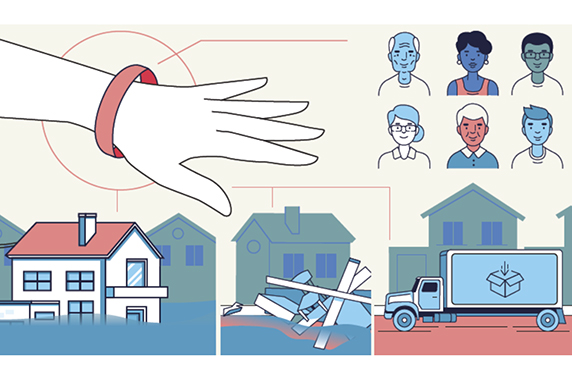During two recent NIEHS Superfund Research Program (SRP) webinars, researchers discussed how climate change can potentially increase exposures to health hazards, as well as what they are doing to tackle this complex challenge.
The webinars were part of SRP’s three-part Climate Change and Health webinar series. The first session, held in October, highlighted strategies to reduce hazardous exposures in the face of climate change.
 “Through the NIH Climate Change and Health Initiative, we are promoting research that develops interventions to help people adapt to the effects of climate change,” said Collman. “That includes early warning systems, community engagement, and strategies to increase education and awareness about climate change.” (Photo courtesy of Gwen Collman)
“Through the NIH Climate Change and Health Initiative, we are promoting research that develops interventions to help people adapt to the effects of climate change,” said Collman. “That includes early warning systems, community engagement, and strategies to increase education and awareness about climate change.” (Photo courtesy of Gwen Collman)Climate Change and Health Initiative
“Extreme weather events, such as hurricanes, extreme heat, wildfires, storms, and floods, are increasing in number every year, becoming more extreme, lasting longer, and having bigger impacts on communities in the U.S. and around the world,” said Gwen Collman, Ph.D., the director of the Office of Scientific Coordination, Planning, and Evaluation at NIEHS.
Collman described some of the impacts of climate change on human health, including heat-related illness, cardiovascular and respiratory disease, mental and neurological disorders, vector- and water-borne diseases, and injuries and death.
“Climate change affects people in every single corner of the world, but those effects are not distributed equally,” Collman explained. “We are focusing part of our work on understanding how to protect underserved populations, such as people of color, low-income populations, immigrant communities, indigenous groups, and people with disabilities.”
Collman serves as the strategic advisor for coordination of the NIH-wide Climate Change and Health Initiative.
“The Biden administration asked all federal agencies to tackle the climate crisis at home and abroad,” Collman said. “NIH rose to the occasion by pulling together a number of institute directors to develop a new research strategy collaboratively to reduce health threats from climate change.”
Hurricane response
 “Hurricane-related changes in the distribution of environmental contaminants and in diet, such as consuming more packaged and processed foods, can lead to changes in exposure with potential health consequences,” Watkins says. “Going forward, I hope to inform practices to protect women and young children from such exposures to mitigate the effects of future storms.” (Photo courtesy of Deborah Watkins)
“Hurricane-related changes in the distribution of environmental contaminants and in diet, such as consuming more packaged and processed foods, can lead to changes in exposure with potential health consequences,” Watkins says. “Going forward, I hope to inform practices to protect women and young children from such exposures to mitigate the effects of future storms.” (Photo courtesy of Deborah Watkins)“Hurricanes are among the most devastating natural disasters,” said Naresh Kumar, Ph.D., from the University of Miami. “They dramatically change the physical landscape, take a heavy toll on human life, demolish infrastructure and property, and exacerbate environmental stressors that persist for months after their landfall.”
Kumar and Deborah Watkins, Ph.D., from the University of Michigan and the Northeastern University SRP Center, described to the webinar participants their separate teams’ efforts to monitor exposures after Hurricane Maria struck Puerto Rico in 2017.
Elena Craft, Ph.D., a former SRP-funded trainee now with the Environmental Defense Fund, spoke about another hurricane that struck the U.S. that year: Hurricane Harvey.
“We partnered with the SRP-funded small business Entanglement Technologies to monitor air pollution in the area,” Craft said. “We also coordinated messaging to make sure that all stakeholders, including residents and state officials, understood the results and were able to make health-protective decisions quickly.”
 After Hurricane Florence struck North Carolina and South Carolina, Craft and collaborators at the Duke University SRP Center and Entanglement Technologies quickly mobilized to characterize contamination in air, water, and soil. From left, Gaston Casillas, Anna Lewis, Tony Miller, Craft, and Gunnar Skulason. (Photo courtesy of Tony Miller)
After Hurricane Florence struck North Carolina and South Carolina, Craft and collaborators at the Duke University SRP Center and Entanglement Technologies quickly mobilized to characterize contamination in air, water, and soil. From left, Gaston Casillas, Anna Lewis, Tony Miller, Craft, and Gunnar Skulason. (Photo courtesy of Tony Miller)“We built our program around disaster preparedness,” Craft explained. “We have tools that allow us to anticipate which facilities will be damaged and which communities are most vulnerable to toxic exposures, as well as a team of partners across the U.S. that can mobilize quickly after a natural or industrial disaster.”
Health impacts of wildfire smoke
 “Data science methods allow us to combine data from different sources and fields of science to answer complex questions, such as the effects of mixtures,” explained Rager, who also co-leads the Data Management Core at the UNC SRP Center. (Photo courtesy of UNC)
“Data science methods allow us to combine data from different sources and fields of science to answer complex questions, such as the effects of mixtures,” explained Rager, who also co-leads the Data Management Core at the UNC SRP Center. (Photo courtesy of UNC)“Wildfires continue to grow in prevalence and intensity, contributing to poor air quality and increased disease risk,” said Julia Rager, Ph.D., from the University of North Carolina at Chapel Hill (UNC) SRP Center.
Wildfire smoke can contain a mixture of compounds from tree combustion, including particulate matter, benzene, formaldehyde, polycyclic aromatic hydrocarbons, volatile organic contaminants, and metals. These compounds often co-occur with chemicals from anthropogenic materials.
Rager and her team are using computational modeling to analyze and group the major constituents of wildfire-associated toxicity based on their source, health effects, chemical structure, and ability to damage DNA.
“The climate crisis is worsening heat and dryness and is predicted to increase wildfires by 50%,” Rager said. “It’s impossible to test every chemical in wildfires, but these new modeling and analytical techniques can improve risk characterization and help us devise strategies to protect health.”
Climate-driven effects and contamination in the Arctic
“The effects of climate-driven changes are more pronounced in Arctic ecosystems,” said Elsie Sunderland, Ph.D., of the Harvard University and University of Rhode Island SRP Centers. “Warming is much more robust, and we see melting permafrost and clearing of sea ice. Of particular concern are indigenous populations and other communities who rely on seafood and marine mammals for subsistence.”
Sunderland explained that many contaminants emitted in lower latitudes can be carried to the Arctic by wind and ocean currents and accumulate there, exposing people to harmful contaminants through diet and other sources.
“As permafrost melts, our models show contaminants — such as methylmercury — that were previously trapped leaking into the ocean, through which they are then redistributed to lower latitudes,” Sunderland said. “These contaminants, which can accumulate in fish, are associated with health effects, including impaired cardiovascular health and neurological disorders.”
(Mali Velasco is a science writer for MDB Inc., a contractor for the NIEHS Superfund Research Program.)










